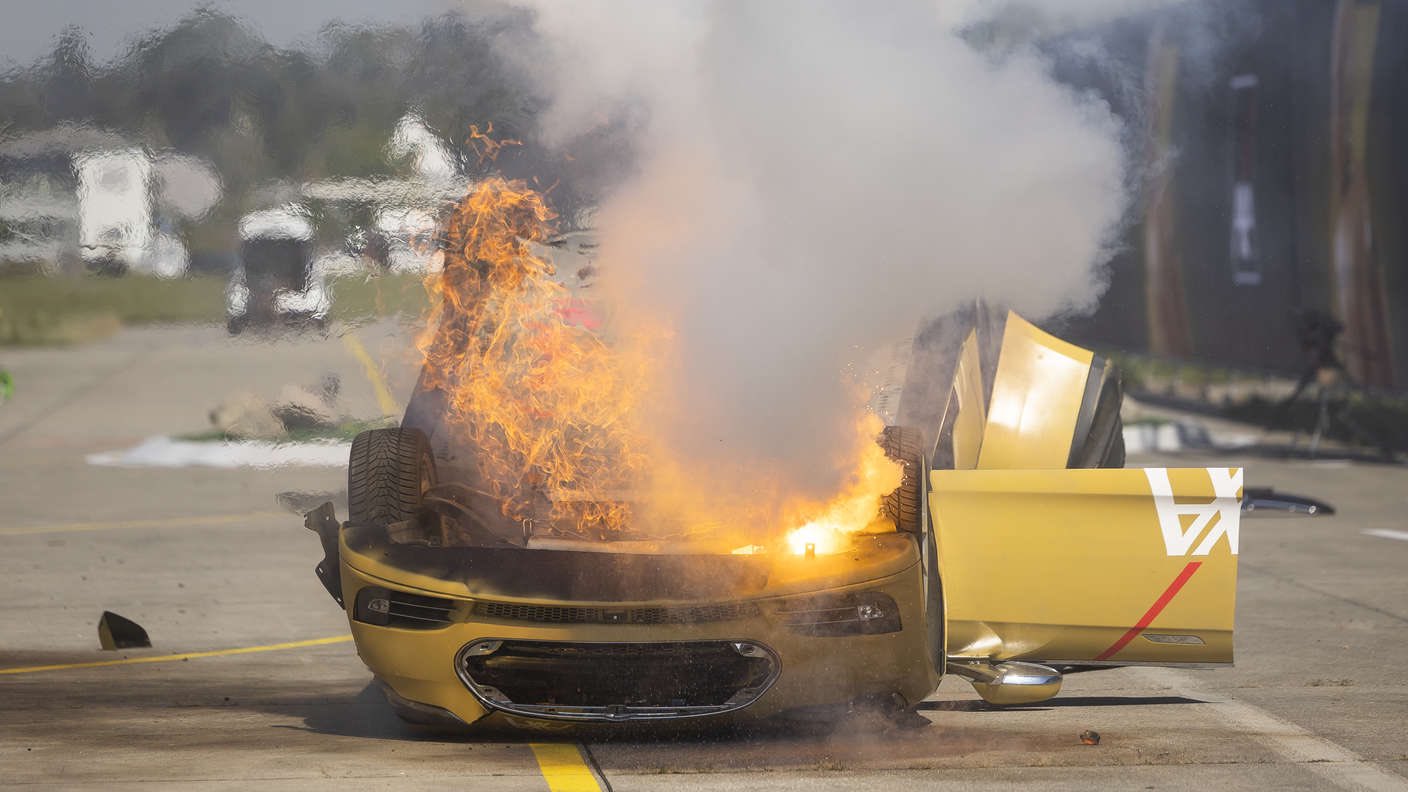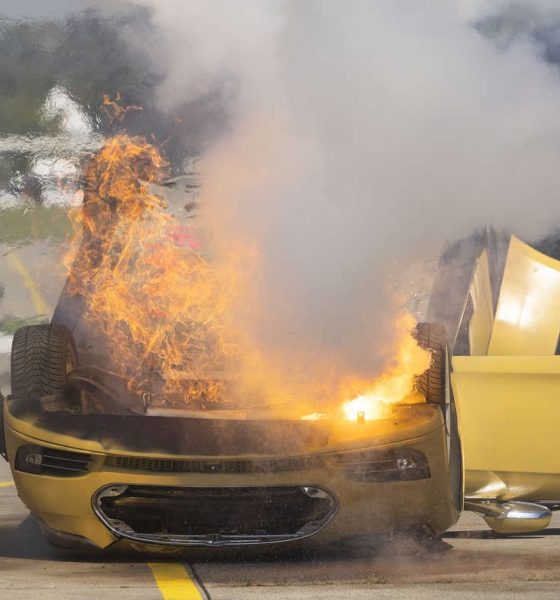An insurance company wanted to prove that Tesla batteries catch on fire and performed a test without the battery. Yes, you read that right. Axa Insurance put on a show marketed as a crash test and admitted to 24auto.de that there were no batteries in the tested videos.
you can’t make this up:
insurer @AXA tries demonstrating the 🔥 dangers of EVs.
a Tesla Model S goes up in flames – but the battery had been removed beforehand.
how did it burn then? 🤔
why, the car was set ablaze by pyrotechnics, of course 🧨🤷♂️— stekkerauto 🚗⚡️ (@stekkerauto) August 30, 2022
According to a statement by the Axa, EVs can pose a risk of fire due to the batteries. However, Axa chose to perform these tests ‘proving’ it by not including the batteries. Instead, they set the car on fire in a different way.
Axa told 24auto.de that it would have been too dangerous to demonstrate an actual battery fire so they removed the battery cells before the tests. This same reasoning applied to their decision to ignite the fire of a Tesla Model S with pyrotechnics.
“For safety reasons, it was not possible to ignite a real battery fire at an event with around 500 people, which is why a fire with pyrotechnics was staged.”
“We wanted to use the fire the accident researchers: on the one hand point out the danger of a cell fire, which can result from damage to the underside of the electric car, and on the other hand point out the problems with fires in electric vehicles in general. Fortunately, fires are very rare in electric cars as well as in conventional combustion engines. In the rare case of a battery fire, so-called thermal runaways can.”
Michael Pfäffli, head of accident research at AXA Switzerland, said that the high torque found in most EVs could result in unwanted, jerky acceleration and loss of control. During the crash test, it was assumed that the driver would lose control of the Tesla which would then roll over on a traffic island.
After the crash, Axa noted that the passenger side was intact but the underbody was badly damaged. Axa researchers also noted that the drive battery was very well protected but could still pose a fire hazard.
The photo provided by Axa and the videos made available to the media show the EV on fire. pic.twitter.com/E2NTqCnSZ1
— stekkerauto 🚗⚡️ (@stekkerauto) August 30, 2022
I have so many questions…
How can you claim that something catches on fire and then do a test without that object? And honestly, anything will catch on fire if you set it on fire. Except for water unless the water is contaminated with something flammable.
In my opinion, this so-called test combined with the claim that fires are rare with conventional combustible engines is just FUD (fear, uncertainty, and doubt).
Another question. How is it legal for any company to openly test a vehicle in this manner on public roads? If they were worried about safety, they shouldn’t be testing and setting cars on fire in places where innocent people could get hurt. Did they have a permit or some type of agency approval for testing?
Tesla owners get criticized for using Full Self-Driving Beta but it’s okay for insurance companies to stage car fires on public roads?
One last question. Would Axa have come out and admitted that this whole thing was staged if 24auto.de hadn’t asked them? They presented the photo to the media which would have harmed Tesla’s reputation. So the question has to be asked, what were Axa’s real motives here?
Note: Johnna is a Tesla shareholder and supports its mission.
Your feedback is important. If you have any comments, concerns, or see a typo, you can email me at johnna@teslarati.com. You can also reach me on Twitter @JohnnaCrider1

News
Tesla starts showing how FSD will change lives in Europe
Local officials tested the system on narrow country roads and were impressed by FSD’s smooth, human-like driving, with some calling the service a game-changer for everyday life in areas that are far from urban centers.

Tesla has launched Europe’s first public shuttle service using Full Self-Driving (Supervised) in the rural Eifelkreis Bitburg-Prüm region of Germany, demonstrating how the technology can restore independence and mobility for people who struggle with limited transport options.
Local officials tested the system on narrow country roads and were impressed by FSD’s smooth, human-like driving, with some calling the service a game-changer for everyday life in areas that are far from urban centers.
Officials see real impact on rural residents
Arzfeld Mayor Johannes Kuhl and District Administrator Andreas Kruppert personally tested the Tesla shuttle service. This allowed them to see just how well FSD navigated winding lanes and rural roads confidently. Kruppert said, “Autonomous driving sounds like science fiction to many, but we simply see here that it works totally well in rural regions too.” Kuhl, for his part, also noted that FSD “feels like a very experienced driver.”
The pilot complements the area’s “Citizen Bus” program, which provides on-demand rides for elderly residents who can no longer drive themselves. Tesla Europe shared a video of a demonstration of the service, highlighting how FSD gives people their freedom back, even in places where public transport is not as prevalent.
What the Ministry for Economic Affairs and Transport says
Rhineland-Palatinate’s Minister Daniela Schmitt supported the project, praising the collaboration that made this “first of its kind in Europe” possible. As per the ministry, the rural rollout for the service shows FSD’s potential beyond major cities, and it delivers tangible benefits like grocery runs, doctor visits, and social connections for isolated residents.
“Reliable and flexible mobility is especially vital in rural areas. With the launch of a shuttle service using self-driving vehicles (FSD supervised) by Tesla in the Eifelkreis Bitburg-Prüm, an innovative pilot project is now getting underway that complements local community bus services. It is the first project of its kind in Europe.
“The result is a real gain for rural mobility: greater accessibility, more flexibility and tangible benefits for everyday life. A strong signal for innovation, cooperation and future-oriented mobility beyond urban centers,” the ministry wrote in a LinkedIn post.
News
Tesla China quietly posts Robotaxi-related job listing
Tesla China is currently seeking a Low Voltage Electrical Engineer to work on circuit board design for the company’s autonomous vehicles.

Tesla has posted a new job listing in Shanghai explicitly tied to its Robotaxi program, fueling speculation that the company is preparing to launch its dedicated autonomous ride-hailing service in China.
As noted in the listing, Tesla China is currently seeking a Low Voltage Electrical Engineer to work on circuit board design for the company’s autonomous vehicles.
Robotaxi-specific role
The listing, which was shared on social media platform X by industry watcher @tslaming, suggested that Tesla China is looking to fill the role urgently. The job listing itself specifically mentions that the person hired for the role will be working on the Low Voltage Hardware team, which would design the circuit boards that would serve as the nervous system of the Robotaxi.
Key tasks for the role, as indicated in the job listing, include collaboration with PCB layout, firmware, mechanical, program management, and validation teams, among other responsibilities. The role is based in Shanghai.
China Robotaxi launch
China represents a massive potential market for robotaxis, with its dense urban centers and supportive policies in select cities. Tesla has limited permission to roll out FSD in the country, though despite this, its vehicles have been hailed as among the best in the market when it comes to autonomous features. So far, at least, it appears that China supports Tesla’s FSD and Robotaxi rollout.
This was hinted at in November, when Tesla brought the Cybercab to the 8th China International Import Expo (CIIE) in Shanghai, marking the first time that the autonomous two-seater was brought to the Asia-Pacific region. The vehicle, despite not having a release date in China, received a significant amount of interest among the event’s attendees.
Elon Musk
Elon Musk and Tesla AI Director share insights after empty driver seat Robotaxi rides
The executives’ unoccupied tests hint at the rapid progress of Tesla’s unsupervised Robotaxi efforts.

Tesla CEO Elon Musk and AI Director Ashok Elluswamy celebrated Christmas Eve by sharing personal experiences with Robotaxi vehicles that had no safety monitor or occupant in the driver’s seat. Musk described the system’s “perfect driving” around Austin, while Elluswamy posted video from the back seat, calling it “an amazing experience.”
The executives’ unoccupied tests hint at the rapid progress of Tesla’s unsupervised Robotaxi efforts.
Elon and Ashok’s firsthand Robotaxi insights
Prior to Musk and the Tesla AI Director’s posts, sightings of unmanned Teslas navigating public roads were widely shared on social media. One such vehicle was spotted in Austin, Texas, which Elon Musk acknowleged by stating that “Testing is underway with no occupants in the car.”
Based on his Christmas Eve post, Musk seemed to have tested an unmanned Tesla himself. “A Tesla with no safety monitor in the car and me sitting in the passenger seat took me all around Austin on Sunday with perfect driving,” Musk wrote in his post.
Elluswamy responded with a 2-minute video showing himself in the rear of an unmanned Tesla. The video featured the vehicle’s empty front seats, as well as its smooth handling through real-world traffic. He captioned his video with the words, “It’s an amazing experience!”
Towards Unsupervised operations
During an xAI Hackathon earlier this month, Elon Musk mentioned that Tesla owed be removing Safety Monitors from its Robotaxis in Austin in just three weeks. “Unsupervised is pretty much solved at this point. So there will be Tesla Robotaxis operating in Austin with no one in them. Not even anyone in the passenger seat in about three weeks,” he said. Musk echoed similar estimates at the 2025 Annual Shareholder Meeting and the Q3 2025 earnings call.
Considering the insights that were posted Musk and Elluswamy, it does appear that Tesla is working hard towards operating its Robotaxis with no safety monitors. This is quite impressive considering that the service was launched just earlier this year.










